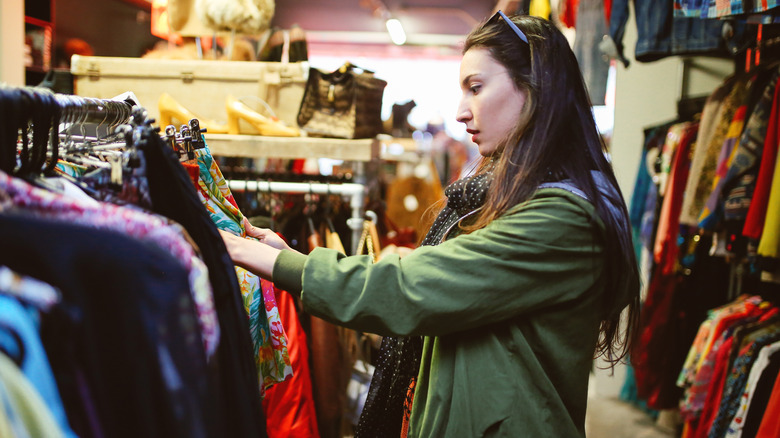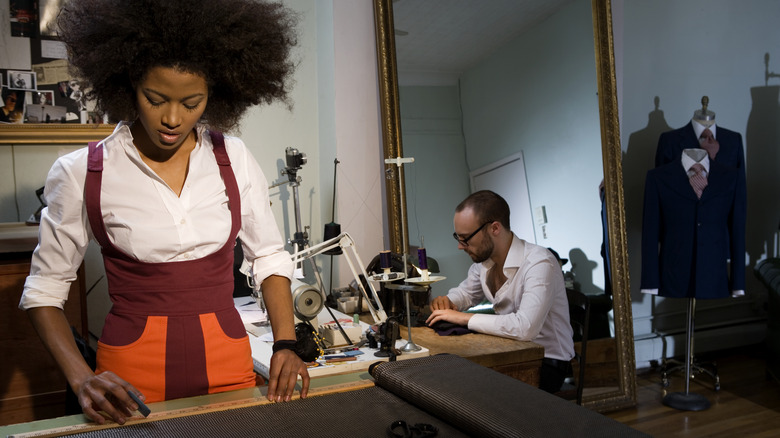'Circular Fashion' Is The Buzziest Sustainable Fashion Trend - Here's What To Know
Over the past decade — but especially the last couple of years — there has been an explosion in the popularity of repurposing and reselling clothing, as reported by Forbes. In fact, a general rise in societal eco-consciousness combined with widespread post-pandemic economic struggles has opened an approach to dressing the masses that the fashion industry didn't know it needed: circular fashion. For decades now, fast fashion has ruled with its cheap, nearly disposable designs meant to last a season and then end up in a landfill, leaching plastic fibers and toxic dyes into groundwater (via the United Nations Environment Programme).
Thanks to a perfect storm of circumstances, an approach to fashion that takes both financial and ecological costs into consideration has emerged. This approach — achieved by prioritizing reusing, reselling, and repurposing existing garments and materials over manufacturing new ones — is known as the circular fashion movement. If you're interested in reducing your carbon footprint and your shopping budget at the same time, embracing circular fashion might be the right move for you.
What exactly is circular fashion?
Circular fashion is an approach to manufacturing clothing and accessories that has no definitive beginning or end. Rather than products being manufactured with the goal of creating as many items for as little cost as possible, circular fashion aims to reduce waste by creating products that can sustain extended wear and reuse and then go on to be repurposed.
While the second part of the circular cycle — reusing and repurposing garments and materials — has been gaining popularity for quite some time, the importance of mindful manufacturing is only recently beginning to see a mainstream shift in priorities. This includes keeping materials as close to their natural state as possible, even when doing so isn't the option with the lowest cost. While some consumers may balk at the idea of the increased cost per garment being passed onto them, the increased longevity and boosted availability of high-quality secondhand garments are undoubtedly welcome industry shifts for consumers.
Why shop and sell secondhand fashion?
Buying and selling secondhand fashion items online or at thrift stores has gone from a shameful secret to a proud hobby, side hustle, or career in the span of just one generation. TikTok — a creator and reporter through-and-through of Millennial and Gen Z lifestyle trends — is full of videos showcasing shameless thrifting adventures and featuring professional fashion resellers. Many of these videos, often labeled #thrifttok, have views in the millions. If you're a trend chaser, this popularity alone might be enough to get you to dip your toe in the pool of circular fashion.
If you need a little more substance than what's trending online, consider the unimaginably significant environmental impact of choosing to participate in the secondhand clothing market. According to ThredUP's 2023 Resale Report, every consumer replacing just one new fashion purchase with a secondhand one in 2023 would save over 20 billion gallons of water and 4 billion kilowatt-hours of energy. Let that sink in.
Ethical considerations
If you've spent any amount of time surfing #thrifttok, you've likely seen hostile arguments break out in the comment sections of popular thrifting videos, as secondhand fashion resellers like @findzbychloe are often targets for accusations of unethical practices. Why? Many commenters believe that secondhand clothing is a limited resource; thus, purchasing secondhand items to resell rather than for personal use, in this opinion, interferes with underprivileged people's opportunity to buy affordable clothing. For instance, under one of Chloe's videos, a TikTok user wrote, "Okay scalper," with a red heart emoji, equating Chloe's thrifting and reselling to the resale of concert tickets — a finite resource.
What protestors of the reselling of secondhand clothing don't seem to consider is just how many clothing items are manufactured each year. According to McKinsey, about 100 billion clothing items are manufactured worldwide annually, and three of every five of them end up in landfills. There is absolutely no shortage of secondhand clothing items available, and fashion resellers are a threat to no one. If you're concerned with making sure that your secondhand reselling is as eco-friendly as possible, consider the environmental impact of shipping involved in online sales. Embracing a policy of attempting to sell your items locally using a service such as Facebook Marketplace before considering more distant options is a reasonable solution to start with.
How to get involved
If you're interested in getting involved in the circular fashion movement on any level, now is the best time to jump right in. In addition to online platforms like ThredUP, Poshmark, and Depop making it easier than ever to sell your used garments, an ever-increasing number of major fashion retailers are joining the fight for sustainability by opening their own official resale platforms, some through their own website and others using third party services (like ThredUP).
In fact, you might be surprised at some of the big-name retailers who have stepped up to participate in circular fashion efforts. Brands like Levi's, H&M, Lululemon, and J.Crew are among the retail giants that have stepped forward to lead the way, but they're not the only ones. A little research can go a long way with saving money and the planet. Follow their lead by purchasing their resale goods and then selling or donating them back into circulation once you've used them to the best of your ability. Then, start the cycle over again with your next purchase.



